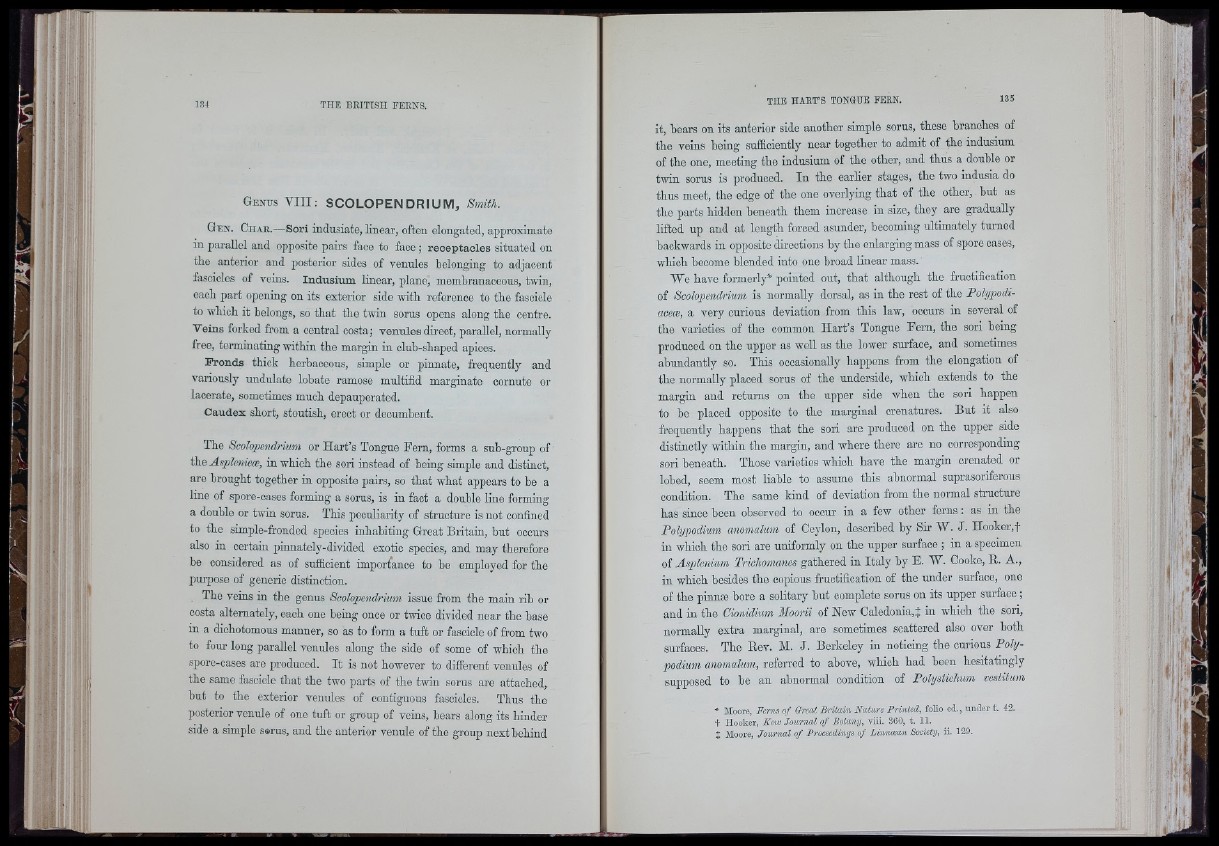
Genus V III; SCOLOPENDRIUM, Smith.
Gen. Char.— Sori indusiate, linear, often elongated, approximate
in parallel and opposite pairs face to face ; receptacles situated on
tho anterior and posterior sides of venules belonging to adjacent
fascicles of veins. Indusium linear, plane, membranaceous, twin,
each part opening on its exterior side with reference to the fascicle
to which it belongs, so that the twin sorus opens along the centre.
Veins forked from a central costa; venules direct, parallel, normally
free, terminating within the margin in club-shaped apices.
Fronds thick herbaceous, simple or pinnate, frequently and
variously undulate lobate ramose multifid marginate cornute or
lacerate, sometimes much depauperated.
Caudex short, stoutish, erect or decumbent.
The Scolopendrium or Hart’s Tongue Fern, forms a sub-group of
the Asplenieæ, in which the sori instead of being simple and distinct,
are brought together in opposite pairs, so that what appears to be a
line of spore-cases forming a sorus, is in fact a double Une forming
a double or twin sorus. This peculiarity of structure is not confined
to the simple-frondcd species inhabiting Great Britain, but occurs
also in certain pinnatoly-divided oxotie species, and may therefore
be considered as of sufficient importance to be employed for the
purpose of generic distinction.
The veins in the genus Scolopendrium issue from the main rib or
costa alternately, each one being once or twice divided near the base
in a dichotomous manner, so as to form a tuft or fascicle of from two
to four long parallel venules along the side of some of which the
spore-cases are produced. It is not however to different venules of
the same fascicle that the two parts of the twin sorus are attached,
hut to the exterior venules of contiguous fascicles. Thus the
posterior venule of one tuft or group of veins, bears along its hinder
side a simple ssrus, and tho anterior venule of the group next behind
it, hears on its anterior side another simple sorus, these branches of
the veins being sufficiently near together to admit of the indusium
of the one, meeting the indusium of the other, and thus a double or
twin sorus is produced. In the earlier stages, the two indusia do
thus meet, the edge of the one overlying that of the other, but as
the parts hidden beneath them increase in size, they are gradually
lifted up and at length forced asunder, becoming ultimately turned
backwards in opposite directions by the enlarging mass of spore cases,
which become blended into one broad linear mass.
We have formerly* pointed out, that although the fruotifioation
of Scolopendrium is normally dorsal, as in the rest of the Polypodi-
aceæ, a very curious deviation from this law, occurs in several of
the varieties of the common Hart’s Tongue Fern, the sori being
produced on the upper as woll as the lower surface, and sometimes
abundantly so. This occasionally happens from the elongation of
the normally placed sorus of the underside, which extends to the
margin and returns on the upper side when the sori happen
to bo placed opposite to the marginal crenatures. But it also
frequently happens that the sori are produced on the upper side
distinctly within the margin, and where there aro no corresponding
sori beneath. Those varieties which have the margin crenated or
lobed, seem most liable to assume this abnormal suprasoriferous
condition. The same kind of deviation from the normal structure
has since been observed to occur in a few other ferns : as in the
Polypodium anomalmn of Ceylon, described by Sir W. J. Hooker,t
in which tho sori are uniformly on the upper surface ; in a specimen
oi Asplenium Trichomanes gathered in Italy by E. W. Cooke, R. A.,
in which besides the copious fruotifioation of the under surface, one
of the pinnæ bore a solitary but complete sorus on its upper surface ;
and in tbe Cionidium Moorii of New Caledonia,]: in wbich the sori,
normally extra marginal, are sometimes scattered also over both
surfaces. The Rev. M. J. Berkeley in noticing the curious Poly-
podium anomalum, referred to above, which had been hesitatingly
supposed to be an abnormal condition of Polysticlmm vestituin
* Moore, Ferns o f Great B r ita in Nature Printed, folio ed ., un d er t. 42.
d Hooker, Kew Jo im ia l o f Botany, viii. 360, t. 11.
Î Moore, Journal o f Proceedings o f Lin noea n Society, ii. 129.
ik
i llil
:i i'l
i:‘i
IM
». 4
i : i-l
" ( t
"I
r'P
; 'i!
11
' IU'
riîiî
'i 11,